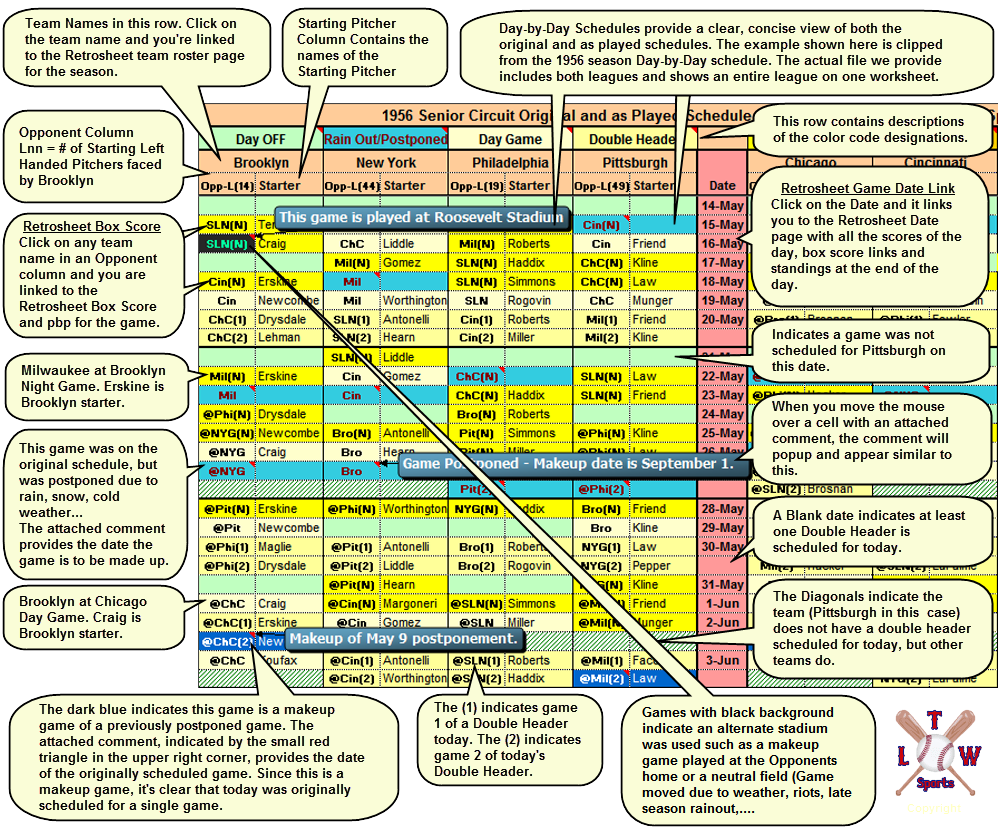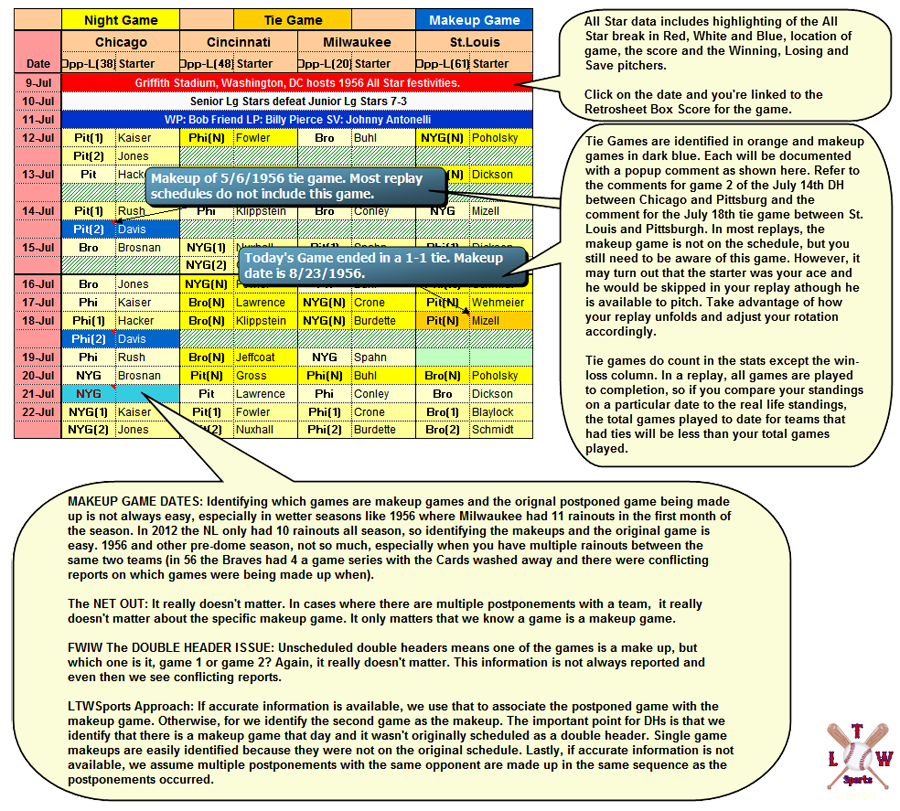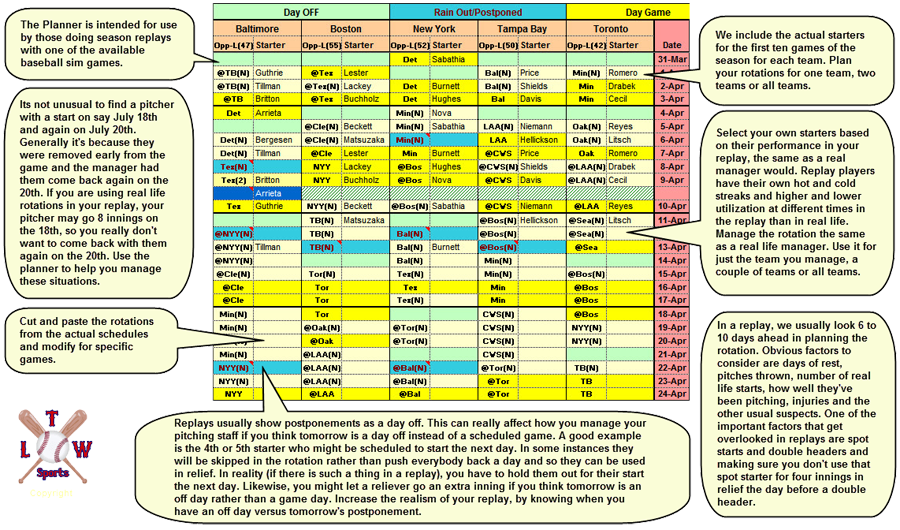|
|
|
|
|
|
|
|
|
Day-by-Day Schedules Examples
|
|
|
|
Our Day-by-Day Schedules provide a complete view of a league’s schedule for a season showing the originally scheduled games, the starting pitchers, postponements, makeup games, tie games, days off and the all-star game. For easy access, clickable links to the Retrosheet box scores and play-by-play for each game are included so you no longer have to do a separate search to find out why a pitcher started two games in three days. Depending on your screen size and the season, you will typically see all the teams in the league and 3 to 5 weeks of games. Check out our examples below to see the details included in our schedules.
|
|
|
|
|
Day-by-Day Schedule Information

|
|
|
|
|
Day-by-Day Schedule More Information
|
|
|
|
|
Day-by-Day Schedule Pitching Rotation Planner
|
|
|
|
|
Our Day-by-Day Schedule provide a concise, easy to use overview of the baseball season for both leagues.
Features:
-
The Day-by-Day Products are Excel spreadsheets that can be viewed using the Microsoft Excel File Viewer, a free download from Microsoft, or Microsoft Excel 2003 or later.
-
A season file includes the original and as played schedules, the starting pitchers and the pitching planner for all teams in both leagues.
-
Each league is presented with all its teams on a single worksheet, ie., one worksheet for each league.
-
The schedules are Day-by-Day and include for each team the opponent, home or away indicator and the team’s starting pitcher.
-
Extensive use of color codes highlight day/night game, double header, postponements, makeup games and tie games.
-
Single click links to the Retrosheet box score and play-by-play for each game.
-
Easy to spot trends such as rotation changes, spot starts, a pitcher moved up/back a day to get a particular matchup. You’ll get a sense for how difficult it is to keep a rotation and how it has to be manipulated during the season.
-
The Pitching Planner worksheets allow you to plan your own rotations for as many teams as you want.
Other items of interest for the replayer:
-
Postponements and off days – Typically, the schedule used in your replays is the “as played schedule” because that allows the use of as played lineups and starting pitching. On the other hand, it means the postponements are viewed as a day off. In terms of pitching usage this can have a significant impact on who gets used in relief. For example, today you have a night game, but tomorrow you have a double header scheduled. You just hope to get 6 or 7 innings out of your starter, so you can save some of your bullpen for tomorrow, but if the starter falters in the 3rd, you’ll have tired arms tomorrow. Likewise an extra-inning game will wreak havoc on the pitching staff. However, in your replay tomorrow is a day off. You may also gain an extra arm or two in the bullpen from the starters that would have been scheduled for tomorrow. Most likely one of them is a spot starter and the other could be a #4 or #5 starter and might actually be skipped because of the rain out. The point is you have a distinct advantage in your bull pen over the real life manager for today’s game. You may think there aren’t that many rainouts so it’s not a big deal in your replay and for dry seasons that may be true. In wet seasons, some teams may have 10 or more rainouts (in 1964 there were 71 postponements, 7 per team average) and that’s a lot of games to have that kind of advantage.
If you really want to face the same challenges as the real life manager and make your replay a little more realistic then here’s a couple of suggestions to try. Use the pitching planner to set up your rotations and include the postponements as games that have to have a starter. That way you’ll know there is a game scheduled for the next day and who should be held out of today’s game. In computer managed games, it really depends on how the computer manager works. One alternative is to make the player inactive for the game. Another is to actually change the schedule and assign the player as the starter. This is a little more work, but it adds to the fun and excitement of the replay. BTW, after the game don’t forget to go back and remove the extra game from the schedule.
-
Tie games – Tie games are a rarity these days, but in older seasons, especially pre-1975, they weren’t that unusual. In 1956 there were 7 tie games. In the baseball sims, usually the tie game itself is on your schedule, but the makeup game is not. What this means to the replayer is that the two starting pitchers in the makeup game are skipped in your rotation (it often affects who’s catching, too). If it’s your ace, you really don’t want them skipped. Since these games are identified on our schedules, it gives you the opportunity to change your rotation to use your ace (the real manager would have) and also means they’re not available in the bullpen. This is not a huge deal, but it does add some interest in how the real life manager would have handled the situation without the extra game. With our schedules you’ll know when this occurs and make your own adjustments.
-
Rotation Planner – the planner actually makes it easier for you plan your own pitching rotations a week to 10 days in advance. Why do this if you’re using the as played lineups and starting pitchers? Actually, there are several reasons. First, you may want to select rotations based on performance in your replay, especially for the 3rd, 4th or 5th starters. Just like in real life, players in the sims have hot and cold streaks and you may want to take advantage of that in your replay. Second, you may disagree with how the real life manager scheduled the rotations. For example you may prefer the actual #3 starter to the #2 starter and so you swap them. Third you may want to do more strategic match ups or avoid certain matchups and change your rotation accordingly. You may only want to do this for the team you’re managing or perhaps a division and not the whole. Use it as you see fit.
Packaging:
The Day-by-Day Schedules and Pitching Planner is available for an individual season and contains the data for both leagues along with the pitching planner. It is also available in a season group package with the Day-by-Day Utilization products at a discount (see the Store for details).
System Requirements:
Microsoft Excel File Viewer or Microsoft Excel version 2003, 2007, 2010 or 2013. Currently, the Microsoft Excel File Viewer can be downloaded from Microsoft for FREE via this link:
http://www.microsoft.com/en-us/download/details.aspx?id=10
or do a query for Excel File Viewer.
Microsoft Windows 8/7/Vista/XP with SP3 (Service Pack 3).
Disk Requirements: For the 2012 season, the Day-by-Day Utilization workbooks are 16 to 18 Mega-Bytes each. The Day-by-Day schedules are about 4 Mega-Bytes. In comparison, the 1956 season Day-by-Day Utilization workbooks are 9 to 11 Mega-Bytes each and the Day-by-Day schedules are about 3 Mega-Bytes.
Use on a MAC: The software has not been validated on a MAC running Excel or any of the MACs running a windows compatible environment.
Important Note: If you use Microsoft Excel to view these workbooks, macros should be enabled for best performance.
|
|
|
|
|
|
|
|
|
|
|
|
|
|